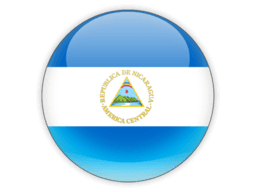
Regions of Nicaragua
Explore 17 regions
Cities of Nicaragua
Discover 50 cities across 17 regions
Boaco Department(3)
Carazo Department(3)
Chinandega Department(5)
Chontales Department(3)
Estelí Department(2)
Granada Department(3)
Jinotega Department(1)
León Department(5)
Madriz Department(1)
Managua Department(7)
Masaya Department(2)
Matagalpa Department(4)
North Caribbean Coast(2)
Nueva Segovia Department(3)
Río San Juan Department(1)
Rivas Department(1)
Nicaragua is a country located in Central America, bordered by Honduras to the north and Costa Rica to the south. Its capital and largest city is Managua. Nicaragua has a population of over 6 million people and is known for its natural beauty, including lakes, volcanoes, and beaches.
The official language of Nicaragua is Spanish, and the country's currency is the Nicaraguan córdoba. The country has a diverse economy, with agriculture, manufacturing, and tourism as key industries.
Tourism is an important part of Nicaragua's economy, with visitors attracted to the country's natural beauty, including its beaches, volcanoes, and wildlife. The country is also home to several historic sites, such as Granada, the oldest colonial city in Central America.
Nicaragua has a tropical climate, with two distinct seasons - a dry season from December to April and a rainy season from May to November. The best time to visit Nicaragua is during the dry season when the weather is sunny and pleasant.
When traveling to Nicaragua, it is important to take safety precautions, as the country has a high crime rate. It is recommended to travel in groups and avoid traveling alone at night. Visitors should also be aware of their surroundings and avoid displaying signs of wealth, as this can make them targets for theft.
Overall, Nicaragua offers visitors a unique and memorable travel experience, with a rich culture and natural beauty that are not to be missed.
Telephone Code
505
Local Emergency Phone
Ambulance: 128; Fire: 115, 911; Police: 118
Vaccinations
Travelers must show proof of yellow fever vaccination administered at least 10 days before travel in order to be permitted entry to Nicaragua. See WHO recommendations.
Climate
Tropical in lowlands, cooler in highlands
Currency (Code)
Cordobas (NIO)
Electricity/Voltage/Plug Type(s)
120 V / 60 Hz / plug types(s): A, B
Major Languages
Spanish, Miskito, Mestizo
Major Religions
Roman Catholic 50%, Evangelical 33.2%, other 2.9%, unspecified 13.2%
Potable Water
Yes, but some opt for bottled water
International Driving Permit
Suggested; additionally, if you plan to drive in Nicaragua, you will need an Inter-American Driving Permit issued by the AAA
Road Driving Side
Right
Tourist Destinations
Somoto Canyon; Masaya Volcano National Park; Cerro Mogotón; Isla Ometepe; Cerro Negro; Pearl Cays; Bosawas Biosphere Reserve
Major Sports
Soccer, baseball, boxing
Cultural Practices
Pointing is accomplished with the lips - pucker the lips and raise the chin briefly in the direction you are pointing to.
Tipping Guidelines
Leaving a 8-10% tip at restaurants is appropriate. Tipping a porter 50 cents (USD), a doorman $1-2 (USD), and hotel housekeeping $1 (USD) per day is common.
Souvenirs
Pottery, hand-woven hammocks, gold jewelry, leather goods, rum, cigars, coffee
Traditional Cuisine
Gallo Pinto — red (kidney) beans and cooked stale rice sautéed in oil with onions and garlic
Geography
Area
total: 130,370 sq km
land: 119,990 sq km
water: 10,380 sq km
Climate
tropical in lowlands, cooler in highlands
Natural resources
gold, silver, copper, tungsten, lead, zinc, timber, fish
People and Society
Population
6,359,689 (2023 est.)
Ethnic groups
Mestizo (mixed Amerindian and White) 69%, White 17%, Black 9%, Amerindian 5%
Languages
Spanish (official) 95.3%, Miskito 2.2%, Mestizo of the Caribbean coast 2%, other 0.5%; note - English and indigenous languages found on the Caribbean coast (2005 est.)
Religions
Roman Catholic 50%, Evangelical 33.2%, other 2.9%, none 0.7%, unspecified 13.2% (2017 est.)
Population growth rate
0.91% (2023 est.)
Government
Government type
presidential republic
Capital
name: Managua
Economy
Economic overview
low-income Central American economy; until 2018, nearly 20 years of sustained GDP growth; recent struggles due to COVID-19, political instability, and hurricanes; significant remittances; increasing poverty and food scarcity since 2005; sanctions limit investment
Real GDP (purchasing power parity)
$38.628 billion (2021 est.)
Real GDP per capita
$5,600 (2021 est.)
Agricultural products
sugar cane, milk, rice, maize, plantains, groundnuts, cassava, beans, coffee, poultry
Industries
food processing, chemicals, machinery and metal products, knit and woven apparel, petroleum refining and distribution, beverages, footwear, wood, electric wire harness manufacturing, mining
Exports
$6.617 billion (2021 est.)
Exports - partners
United States 60%, El Salvador 5%, Mexico 5% (2019)
Exports - commodities
clothing and apparel, gold, insulated wiring, coffee, beef (2019)
Imports
$8.306 billion (2021 est.)
Imports - partners
United States 27%, Mexico 12%, China 11%, Guatemala 9%, Costa Rica 7%, El Salvador 6%, Honduras 6% (2019)
Imports - commodities
refined petroleum, clothing and apparel, crude petroleum, packaged medicines, insulated wiring (2019)
International Airports in Nicaragua
Discover 3 major airports serving Nicaragua
Mark Nicaragua as Visited
Add Nicaragua to your personal travel map and track your journey around the world. Share your adventures and see your progress grow!